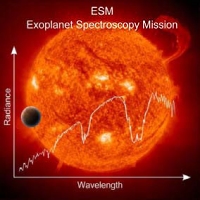Exoplanet Spectroscopy Mission (ESM)
Scientific goals
 |
The primary scientific objective of the ESM mission is to analyze and determine the composition of the atmospheres of transiting exoplanets. This is possible by observing the exoplanet and its parent star during a primary (or secondary) transit, when the planet passes in front of (or behind) the star.
The planet's atmospheric constituents can be revealed by analyzing the characteristic absorption lines they imprint in the spectrum of the star when the star's light passes through the planet's atmosphere during a primary transit. Secondary transits provide an alternative method. Just before or after a secondary transit, the combined light from the star and exoplanet is seen. When the planet is entirely behind the star's disk, only the light from the star is seen. Taking the difference of these two signals reveals the spectrum of the exoplanet alone, which can be analyzed to identify the composition of the planet's atmosphere.
In addition to transiting exoplanets, ESM could observe non-transiting exoplanets and could also be used to observe and study transiting binary stars or brown dwarfs.
To achieve its scientific goals ESM would require a large telescope (at least a 1.2-metre primary mirror) with detectors operating in the near infrared part of the electromagnetic spectrum, covering the wavelength range 0.7 - 10 μm (possibly up to 15 μm). The ESM telescope would operate from an orbit around the second Lagrange point L2 of the Sun-Earth system.
Assessment study
The CDF assessment study of the ESM mission concept ran from 16 February to 26 March 2010. The internal final presentation of the ESM assessment study, prepared by the ESM/CDF team, is now available in PDF format. The document can be retrieved through the link in the right-hand menu under "related publications".
